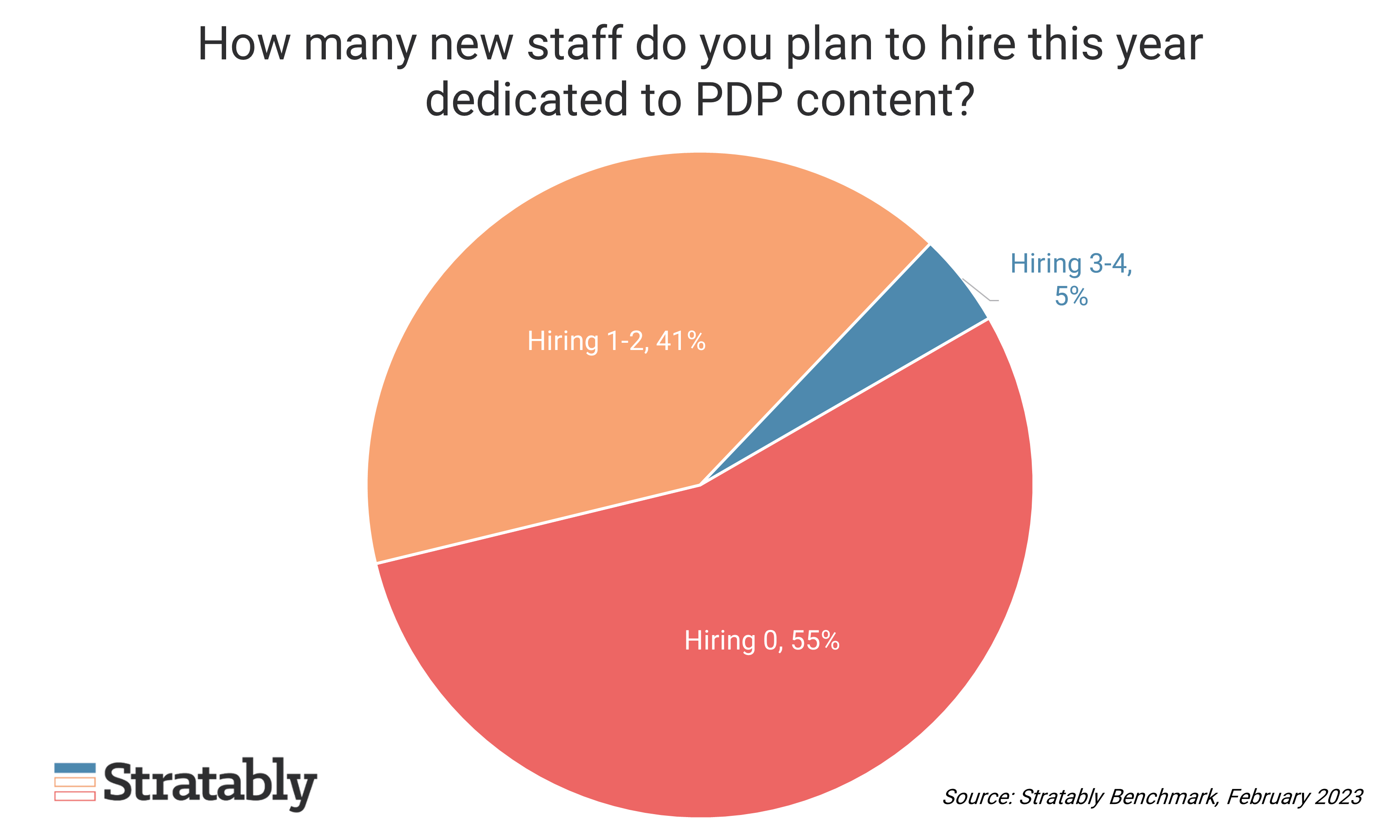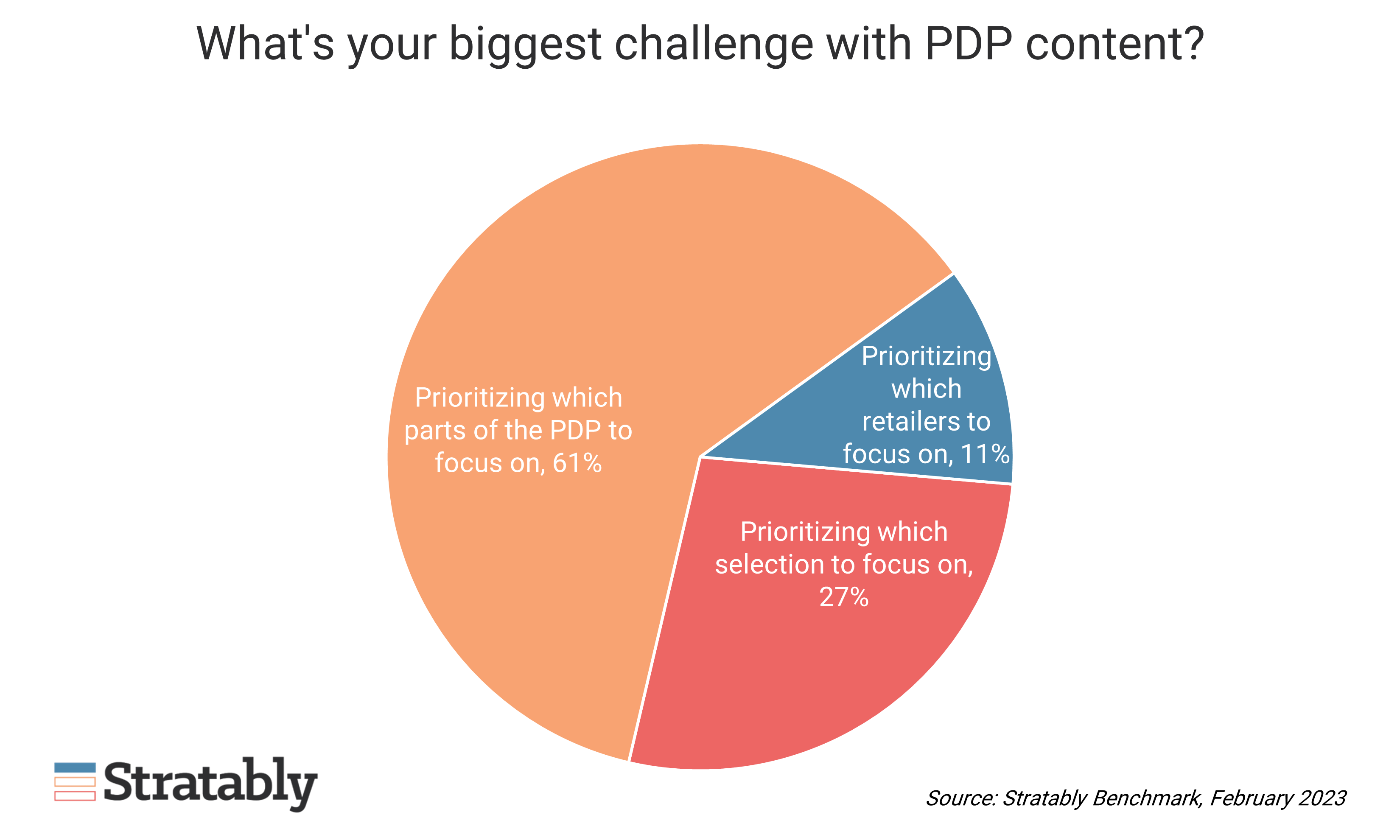February 23, 2023
Stratably hosted Amanda Wolff from OneSpace, an Ascential Company, to walk through the modern approach towards measuring digital shelf effectiveness.
Watch the session here
Nearly half of brands are hiring staff dedicated to PDP content
PDP content is a fluid aspect of doing business with retailers. New components to PDP pages along with the growing importance key retailers are placing on PDPs are resulting in greater complexity for brands to manage.
Nearly half of brands recognize this growing challenge and are adding staff dedicated to PDP content. For context, this rate of hiring is similar to prior years and remains below the rate of hiring brands are doing for retail media, based on Stratably’s research.
Brands wonder how to prioritize product detail page (PDP) initiatives
Stratably’s research indicates brands are primarily challenged with prioritizing which components of the PDP to prioritize, followed by how to allocate time and resources across their selection, and finally, which retailers to focus on.
Limits to measuring effectiveness prevents incremental investment
The reason brands struggle with determining which parts of the PDP to focus on is because measurement is challenging.
The many moving parts to a business, such as competitive forces, ongoing promotions, shifting advertising campaigns, and so on make isolating the impact of a PDP change difficult.
CFOs are (rightly) hesitant to invest in PDP initiatives like video creation or digital shelf auditing tools if they’re not presented with a persuasive ROI.
Thus, it’s key to develop a baseline measurement for sales, search frequency, conversion rate, and the impact to media metrics like CPCs, and then implement a framework for attributing partial credit to outside variables that could be impacting results post PDP change.
Most brands don't incorporate the knock-on effects of PDP improvements on media
The key principle shared was that organic relevance positively impacts paid media efficiency, but too few brands consider that impact. This then limits the financial benefit ascribed to PDP initiatives, and possibly overstates advertising returns.
For instance, if a brand invested in a PDP optimization effort that helps with organic relevance, that ultimately helps improve paid media efficiency. But if that linkage is not made, then the brand will be in the dark as to why the return on their media spend is improving, and it won’t understand that investing on the organic side is showing as “positive returns” on the ad side.
This disconnect is often driven by organizational siloes, whereby brand teams that are often the owners of PDP content are distinct from the teams running retail media.
Here’s what else we found most interesting from the live session:
- Our thinking should shift from “completeness” to “effectiveness” when it comes to PDPs. Meaning, instead of checking the box that we’ve met a given retailer’s requirements, which is table stakes, we should instead consider how our PDP changes are impacting real business metrics like sales.
- There are a few ways to think about a good cadence for PDP optimization. First is with internal triggers (like a formulation change) or external triggers (like a retailer has a new requirement). Beyond that, once a quarter is reasonable for key items, and then annually for longer tail items, particularly for companies with large portfolios.
- Brands can’t stop other variables from moving when they go to evaluate PDP changes. But tracking positive and negative contributors to sales or whatever metric is being evaluated and assigning weights can help narrow in on the actual effect from the PDP change.
- Competitive benchmarking is a typical method for evaluating whether PDP content is “good”. Some brands will start by tracking the number of claims their competitors are making, or subjectively looking at category leaders to see what type of unique PDP content they are implementing.
- Brands will find it difficult to measure improvement from very small PDP changes, such as changing a few keywords. This implies that bigger changes to PDPs should be the focus rather than small, incremental updates.
Additional Resource
Amanda and her team, in partnership with the DSI, wrote a paper about “Minimally Viable Product Detail Pages” that includes examples of Good, Better, Best PDPs across categories. You can download it here.
Watch the session here





